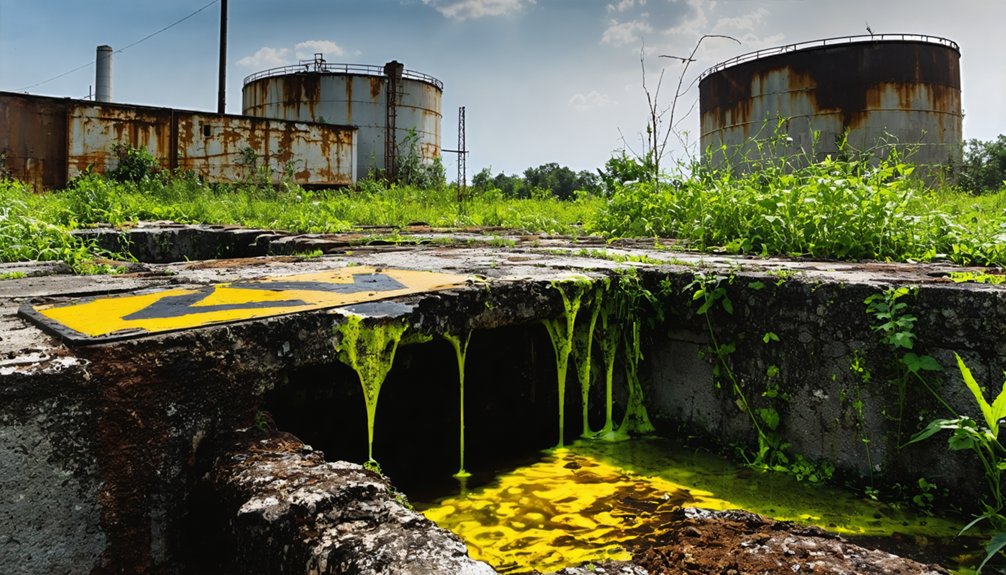You’ll find Taft, Louisiana‘s ghostly remains in St. Charles Parish, where a once-thriving community of 700 residents emerged around cypress mills in 1905. The town flourished with its first post office, railroad connections, and the Cummings-Moberly Cypress Company until 1918. By the 1960s, chemical plants like Union Carbide began displacing residents, and the population dwindled to zero by 2000. The town’s transformation from sawmill settlement to industrial zone tells a deeper story of Louisiana’s changing riverside communities.
Key Takeaways
- Taft transformed from a 700-resident agricultural community to an industrial ghost town, with its population dropping to zero by 2000.
- The 1909 railroad completion and 1918 closure of Cummings-Moberly Cypress Company marked the beginning of Taft’s economic decline.
- Industrial expansion, particularly petrochemical facilities like Union Carbide in 1966, forced residents to relocate due to environmental hazards.
- The closure of local businesses, post office, and churches by 1967 reflected the community’s rapid abandonment.
- Historic structures like the Zeringue House and Holy Rosary Cemetery remain as remnants of Taft’s pre-industrial past.
The Rise and Fall of a River Town
Although Taft began as a promising river settlement in Louisiana, its transformation from an agricultural community to an industrial powerhouse marked one of the most dramatic changes in the state’s economic landscape.
You’ll find the first signs of this shift in 1907 when the town’s first sawmill opened, setting the stage for rapid industrialization. Like President William Howard Taft’s advocacy for duty-free trade with the Philippines, the town’s economic policies focused on growth and expansion.
The community’s resilience was tested as it evolved from agricultural roots, where Colonial Dairy Farm and cypress harvesting once thrived, to a petrochemical hub. The area included the historic Star Plantation near the intersection of La. 3142, which would later become part of the Dow Chemical Company site.
By 1966, Union Carbide‘s arrival accelerated this transformation, followed by the Star plant in 1980.
This industrial legacy came at a steep price – the town’s population steadily declined until reaching zero by 2000, and its residential character disappeared as chemical plants and processing facilities claimed the land.
Early Settlement and Community Growth
You’ll find that Taft’s first major step toward becoming an established community came with the opening of its post office on June 7, 1905, under postmaster Louis A. Barre.
The post office served a population of roughly 700 residents, marking Taft’s emergence as a growing river settlement along the Mississippi’s west bank.
While agricultural ventures initially drew settlers to the area in the early 1700s, the cypress lumber industry would later attract workers and foster the town’s brief period of growth. The area was originally part of the German Coast settlement, where German immigrants established successful farms that supplied New Orleans markets.
The Cummings-Moberly Cypress Company operated in the area until 1918, when their operations ceased due to depleted timber resources.
First Post Office Opens
The establishment of Taft’s first post office in 1905 marked a significant milestone in the community’s development, serving approximately 700 residents during a period of rapid industrial growth.
The post office significance extended beyond just mail service, as it represented Taft’s evolution from a rural outpost into an organized settlement with formal institutions. Like neighboring Allemands post office, the facility played a vital role in connecting the region’s settlements through mail service. Following the nationwide trend of selecting locations based on performance, the post office was carefully positioned to maximize accessibility for local residents.
- The post office became a central hub for community communication, connecting residents with the outside world during the area’s industrial transformation.
- You’ll find it operated continuously for 62 years, serving both townspeople and workers from nearby chemical and phosphate processing plants.
- Its presence helped establish Taft as a legitimate, permanent settlement, building upon the foundation laid by earlier institutions like the Holy Rosary Catholic Church.
The post office would continue serving the community until its closure in 1967, coinciding with Taft’s shift toward heavy industrialization.
Cypress Mill Attracts Workers
Prior to the post office’s arrival, Taft’s identity had been shaped by its bustling cypress mill operations, which drew hundreds of workers to the region in the early 1900s.
You’d find workers flocking to the area, drawn by the promise of steady employment in the booming cypress industry, despite the challenging labor conditions they’d face.
The mill provided simple cypress-built homes for its workforce, creating a close-knit community where families lived and worked together.
You’d see workers battling harsh conditions in mosquito-infested swamps, pulling logs using oxen and mules while developing innovative canal networks.
The mill’s daily operations began at 6 AM sharp, with laborers working long hours to maintain the demanding production schedule.
The mill’s success, similar to the renowned F.B. Williams Cypress Company, transformed Taft from a mere workplace into a thriving settlement, where the economic benefits supported thousands of workers and sparked the growth of local businesses.
The dedicated workers spent weeks in the swamps while harvesting the towering cypress trees, showing remarkable commitment to their demanding profession.
Industrial Transformation Through the Years
During Taft’s early industrial development, dramatic shifts transformed this small Louisiana community from an agricultural hub into a concentrated industrial zone.
You’ll find that Taft’s industrial legacy began with modest ventures like the Colonial Dairy Farm and sawmill operations in the early 1900s, but the real transformation accelerated in the 1960s when chemical giants moved in. The community’s industrial roots can be traced back to first sawmill operations in 1907. The rising demand for oil led to record high prices in 2008, further fueling industrial growth in the region.
The community displacement became evident as the population plummeted from 700 to just 36 residents by 1977, while industrial expansion flourished:
- Union Carbide established its chemical facility in 1966
- Hooker Chemical converted dairy farmland into industrial zones
- IMC-Argico launched phosphate processing operations
Today, you’ll see virtually all of Taft’s land dedicated to heavy industry, including chemical manufacturing and nuclear power generation, marking a complete departure from its agricultural roots.
Historic Architecture and Landmarks
When you visit Taft’s architectural heritage, you’ll find several preserved antebellum mansions from the early 1800s, including the 1805 Zeringue House with its attached Lucy schoolhouse and the 1830 Trosclair-Triche House.
The 1840 Troxler House and Jacques Roussel House stand as evidence to the region’s early 19th-century residential design, reflecting the architectural styles prevalent during Louisiana’s pre-Civil War period.
While the original Our Lady of the Holy Rosary Catholic Church was relocated to Hahnville in 1963, its cemetery remains an active burial ground, preserving the religious heritage of Taft’s early community.
Preserved Antebellum Mansions
Like many historic Louisiana towns, Taft’s architectural legacy is best represented through its Greek Revival mansions built between 1830-1860.
You’ll discover these antebellum architecture masterpieces showcase the region’s commitment to historic preservation, with their defining characteristics of symmetrical design and imposing columns that exemplify the period’s architectural grandeur.
- The mansions feature prominent porticos supported by towering columns, creating an impressive entrance that reflects the era’s appreciation for Classical Greek design.
- Each mansion’s perfectly balanced facade demonstrates the meticulous attention to symmetry that dominated antebellum architecture.
- The preserved properties maintain their original structural elements, including grand entrances flanked by matching wings, showcasing the skilled craftsmanship of 19th-century builders.
These surviving structures stand as symbols of Louisiana’s architectural heritage, offering you a glimpse into the state’s prosperous past.
Cemetery’s Religious Heritage
As a tribute to Louisiana’s deep Catholic roots, Holy Rosary Cemetery stands as Taft’s most significant religious landmark, encompassing over 1,600 documented memorials that trace the community’s spiritual heritage.
You’ll discover traditional grave markers that reflect the region’s faith traditions, where local families have gathered for generations to honor their loved ones through time-honored memorial practices.
The cemetery’s sacred grounds serve as more than just a final resting place – it’s a living reflection of the area’s enduring Catholic identity.
While the adjacent petrochemical plant represents modern industry, Holy Rosary remains a steadfast symbol of religious continuity.
Here, community members still come together for religious ceremonies and remembrance, maintaining their spiritual connection despite the changing industrial landscape that surrounds this hallowed ground.
Religious Heritage and Sacred Grounds

Though Taft stands largely abandoned today, its religious heritage remains deeply rooted in the establishment of Our Lady of the Holy Rosary Catholic Church in 1866.
You’ll find sacred spaces that have endured despite industrial encroachment, particularly the historic cemetery now surrounded by Dow Chemical facilities. The church’s founding by Reverend Gustave Jobard strengthened community ties among French, Canadian, and German settlers who made the German Coast their home.
Three enduring legacies of Taft’s religious heritage:
Taft’s religious legacy lives on through its active cemetery, detailed church records, and original grounds – enduring testaments to faith and heritage.
- The active cemetery continues serving families, preserving ancestral connections
- Church records document generations of baptisms and marriages, revealing deep cultural roots
- Original church grounds stand as proof of immigrant faith and perseverance
These sacred grounds bridge past and present, maintaining spiritual connections even as Taft transformed from thriving town to industrial zone.
Economic Forces Behind the Exodus
When railroad construction neared completion in 1909, Taft’s economic foundation began to crumble. You’d have witnessed a dramatic economic decline as dangerous working conditions, accidents, and disease drove workers away from the once-thriving railroad town.
The community exodus accelerated in the 1960s when major chemical corporations like Union Carbide and Hooker Chemical transformed agricultural lands into industrial zones.
You’d have seen your neighbors face tough choices: relocate for safer living and better jobs, or endure deteriorating conditions. Local businesses, the post office, and churches shuttered one by one.
Environmental Impact and Industrial Hazards

The industrial transformation that drove residents from Taft left behind a toxic legacy of environmental hazards.
You’ll find the area now choked by industrial pollution, with petrochemical facilities releasing toxic smoke and contaminating local waterways. The struggle for environmental justice continues as majority-Black communities bear the brunt of these hazards, breathing some of the nation’s most dangerous air.
- Abandoned oil and gas wells pepper the landscape, leaking methane and threatening groundwater.
- Four out of twelve facilities regularly violate Clean Air Act standards, facing minimal consequences.
- Historic Black cemeteries and cultural sites face destruction from unchecked industrial expansion.
What’s more, Louisiana’s inadequate regulatory oversight has left residents exposed to generations of health risks, while companies continue operating with limited accountability.
The environmental burden remains heaviest on those with deep ancestral ties to the land.
Life in Modern-Day Taft
Modern-day Taft stands as a stark industrial landscape where bustling neighborhoods once thrived, with its population having dwindled to zero by the 2000 Census.
You’ll find no residential areas here anymore – just the imposing presence of massive industrial complexes like the Mosaic Company phosphate plant and Dow’s petrochemical facilities.
The town’s industrial legacy now dominates the landscape, with only ghostly remnants of its community past remaining.
While you won’t encounter any active neighborhoods or public services, the historic cemetery stands as a solitary connection to Taft’s former life.
It’s still used for burials today, though surrounded by industrial facilities.
The transportation network now solely serves the industrial sector, reflecting Taft’s complete transformation from a living community to an industrial powerhouse.
Preserving the Memory of a Lost Community

Key preservation elements include:
- The active Holy Rosary Cemetery, which continues to connect families to their heritage.
- Historical artifacts and records housed in regional museums documenting Taft’s social changes.
- Documented accounts of major events, like the 1982 Union Carbide explosion, that shaped the area’s development.
Physical remnants like the 1805 Zeringue House stand as rare surviving structures, testifying to Taft’s rich architectural past amid today’s industrial landscape.
Frequently Asked Questions
Are There Any Ghost Stories or Paranormal Activities Reported in Taft?
You won’t find documented ghost sightings or paranormal investigations in this location. Available research sources don’t mention supernatural activity, likely due to restricted access from industrial zones and chemical plants dominating the area.
What Happened to the Students After the Cummings-Moberly School Closed?
Imagine your own school suddenly closing forever. Records don’t tell us where these students went, but given Taft’s isolation, they likely moved with their families to find new schools and opportunities elsewhere.
How Do Local Authorities Maintain Security in This Abandoned Industrial Area?
You’ll find security measures including fencing, locked gates, surveillance cameras, and regular patrols protecting these abandoned properties, while local law enforcement coordinates with community members to monitor suspicious activities.
Were There Any Notable Crimes or Mysteries Associated With Taft?
You’ll find numerous unsolved cases from Taft’s lawless heyday, when murders and mysterious disappearances were common among railroad workers, fueled by the town’s 27 saloons and absent law enforcement.
Do Any Former Residents Hold Regular Reunions or Commemorative Events?
You won’t find any documented reunion activities or formal gatherings of former residents. While families may visit the Holy Rosary Cemetery occasionally, there’s no evidence of organized commemorative events sharing former resident stories.
References
- https://www.traillink.com/historic-places/the-railroad-ghost-town-of-taft/
- https://en.wikipedia.org/wiki/Taft
- https://973thedawg.com/ixp/38/p/louisianas-most-deserted-ghost-towns/
- https://scphistory.org/taft-town-history/
- https://www.shreveporttimes.com/story/news/2025/09/04/does-louisiana-have-any-ghost-towns-how-many-are-there-where-to-find-abandoned-towns/85972403007/
- https://710keel.com/discover-70-ghost-towns-from-across-louisiana/
- https://www.lsuagcenter.com/portals/our_offices/parishes/st charles/features/about_the_parish
- https://scphistory.org/scp-in-spotlight/
- https://en.wikipedia.org/wiki/St._Charles_Parish
- https://www.bayoubrief.com/2018/09/08/introducing-petrostate/



